To run successful Facebook ads, create a Facebook Ads Manager account and install Meta Pixel on your site. From here, our experts offer step-by-step tips for Facebook ads success.
With over 3 billion active users each month, Facebook continues to be the most popular social media platform in the world.
Despite its large reach, however, Facebook ads have a reputation for low engagement. That’s why advertisers need to work extra hard to run Facebook ads that boost brand awareness and turn scrollers into customers.
Here, our team of experts walks you through the steps we use to help our clients achieve a higher ROI.
What are Facebook ads?
Facebook ads are sponsored posts that appear across Facebook’s network that promote a business’s brand, products, or services.
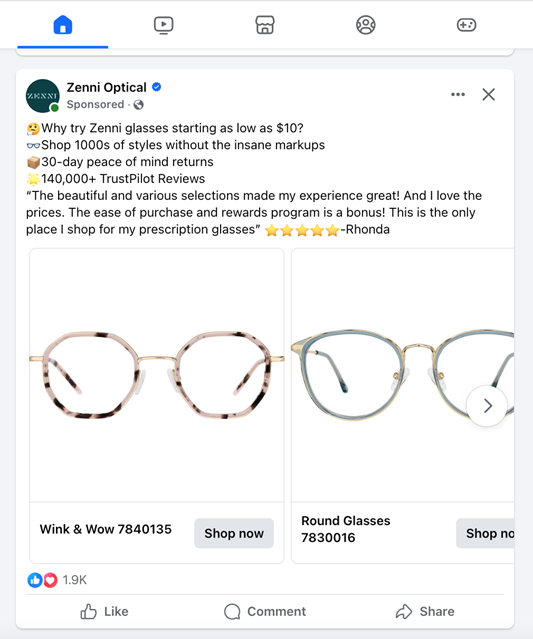
(Image: Facebook screenshot)
Also called Meta ads, Facebook ads target people based on their age, interests, and online behavior to reach the right audience. Advertisers pay a fee based on how many people see or click on their ads.
How do Facebook ads work?
Brands create ads that show up in their target audience’s Facebook feeds and stories, as well as other places on Facebook and Instagram.
Here’s how it works:
- Advertisers choose a goal (like more website visitors or sales)
- Select the type of audience they want to target, their budget, and maximum bid for each ad’s view (CPM) or click (CPC)
- Facebook uses an ad auction system to determine which ads to show to the most relevant people
- The advertiser pays when someone clicks on their ad, or each time they reach 1,000 impressions (views)
Why advertise on Facebook?
No matter who your audience is, you’re likely to find them on Facebook. With the right strategy, you can build a social media advertising campaign that reaches them.
Facebook ads:
- Build brand awareness
- Benefit other digital marketing campaigns, like Google Ads
- Reengage and retarget your audience
- Is the largest social media platform, offering a large audience
- Has precise micro-targeting options that segment custom audiences
- Are cost-effective with flexible budgeting options and a lower cost per click (CPC) than other platforms
- Include built-in analytics and detailed reporting that offers insights into metrics like impressions, reach, clicks, click-through rate (CTR), CPC, conversion rate, and return on ad spend (ROAS)
Meta ads are maintaining dominance in the paid social space since Meta properties like Facebook, Instagram, and Messenger have the largest number of users in the world with over 6 billion monthly active users and the ability to drill down on targeting.
“We’ve learned that these ads are most effective when utilized in a comprehensive digital marketing strategy/campaign including, paid search, SEO, remarketing, and video, to name a few,” says Rambod Yadegar, President of HawkSEM.
Further reading: See how we helped ecommerce client Apotheke Co. effectively position its products to its target audience and acquire new customers with advice from our paid social experts.
How to run successful Facebook ads
- Create a Facebook Ads Manager account
- Install the Meta Pixel
- Go to Facebook Ads Manager
- Select your objective
- Choose your audience
- Set your Facebook ads budget
- Create a compelling Facebook ad
- Track and optimize your results
- Build a report to share with the team
1. Create a Facebook Ads Manager account
Facebook Ads Manager is a tool to create, manage, and track ads across Meta. This includes Facebook as well as Instagram, Messenger, the Audience Network (third-party apps and sites), and even WhatsApp.
To create an ad account, you need to set up a Facebook Business Page.
Then:
- Go to Meta Business Suite
- Click ‘Create Account’
- Add your Facebook Business Page account (a personal Facebook page won’t work)
- Fill in your account details (business name, your name, and email address)
- Click Next
- Enter any additional details, like your address, phone number, and website
- Submit
- When you receive a confirmation email, click Confirm Now
Then, you can handle all your Meta-related business items within the Meta Business Suite.

(Image: Meta screenshot)
2. Set up Meta Pixel
Meta Pixel (formerly Facebook Pixel) is a snippet of code you can add to your website that monitors visitor activity after they click on your Facebook ad.
While this step isn’t absolutely necessary, Meta Pixel integrates with platforms like WordPress, Shopify, and Squarespace to:
- Provide granular insights and analytics (e.g. scroll depth, button clicks, and form submissions).
- Improve ad targeting
- Enhance performance tracking
- Optimize ad delivery
- Improve cost efficiency
Here’s how to get started with Meta Pixel:
- Create your Pixel
- Log in to your Meta Events Manager
- Click on “Connect Data Sources” and select “Web”
- Click “Connect”
- Enter a name for your Pixel and click “Create Pixel”
- Install the Meta Pixel on your website
There are a couple of ways to do this:
Partner integration
If your website is hosted on platforms like WordPress, Shopify, or Squarespace, Meta offers direct integrations.
- In Events Manager, after creating your Pixel, select “Use a Partner Integration.”
- Then, simply choose your platform and follow the on-screen instructions to complete the setup.
Manually
- After creating your Pixel, select “Install code manually”
- Copy the Pixel base code provided
- Paste this code into the header section of your website (just above the closing </head> tag) on the pages you wish to track
- Save and publish the changes to your website
- Verify Pixel installation
You can use the Meta Pixel Helper Chrome extension to ensure the Pixel is correctly installed.
Simply visit your website and click on the extension icon – it will indicate whether your Pixel is active and functioning properly.
- Set up events
- In Events Manager, use the “Event Setup Tool” to define and track these actions without additional coding
Pro tip: Meta Events Manager is gradually changing how your event data is shown. So if your data seems to have disappeared, don’t worry. Keep up with the dataset rollout to stay on top of your campaigns.
3. Create a campaign in Facebook Ads Manager
To navigate to Ads Manager, click the hamburger menu icon located at the top left corner of the screen (labeled as ‘All tools’).
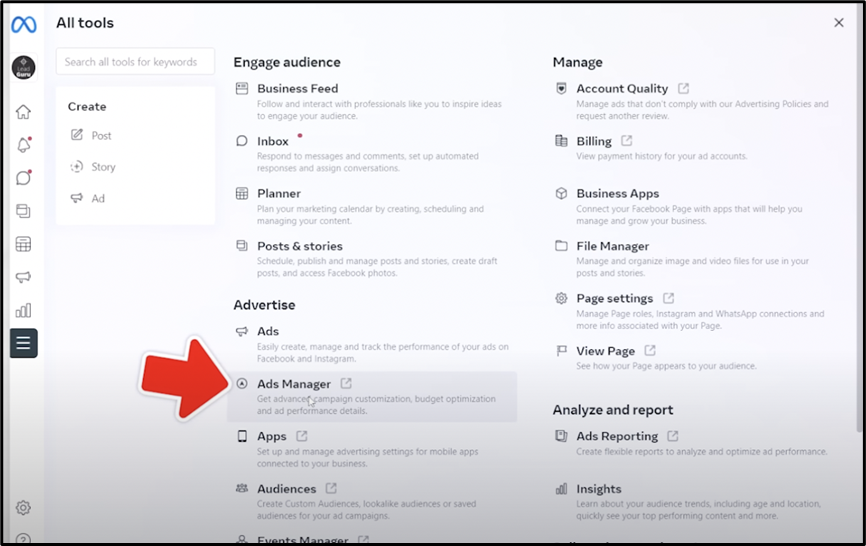
(Image: Meta screenshot)
To start creating campaigns, select ‘Create.’
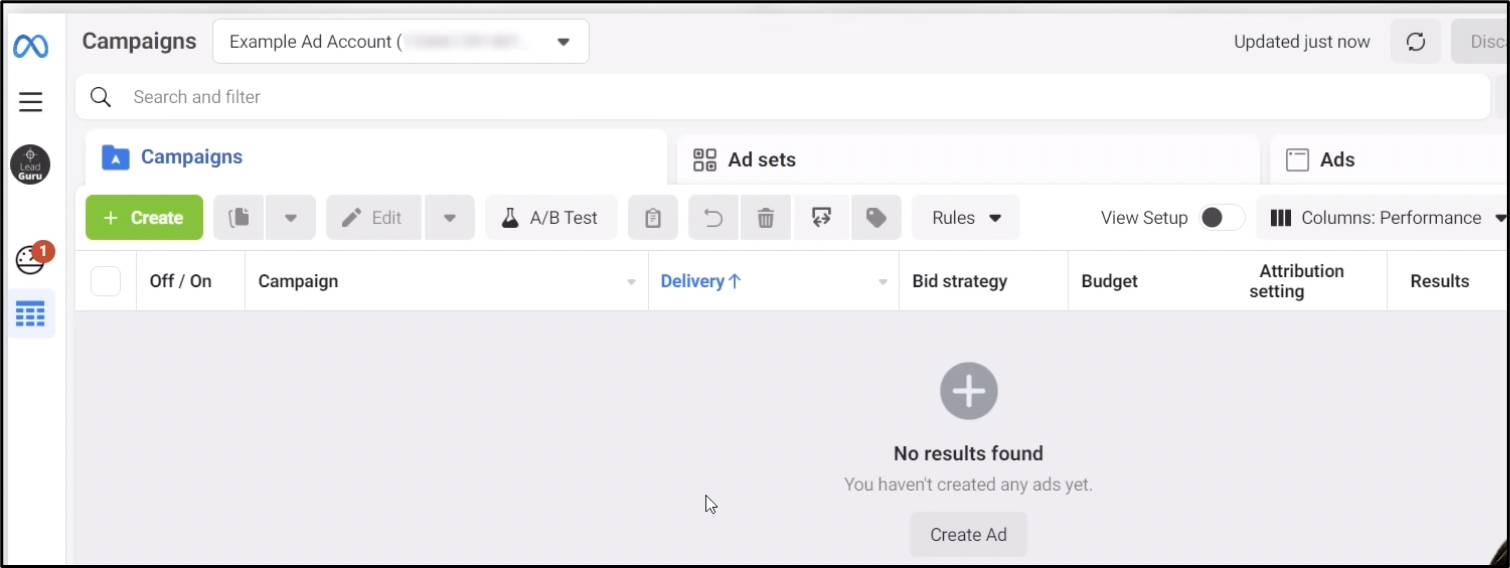
(Image: Meta screenshot)
4. Select your objective
After that, pick a campaign objective that aligns with what you hope to achieve with your ad. Options include:
- Awareness
- Engagement
- Traffic
- Leads
- Sales
- App promotion
Pro tip: If you want specific results (like more traffic, engagement, or sales), you’ll be charged per action taken. But if you just want to boost visibility (like getting more website visits), you’ll pay based on the number of times your ad appears.
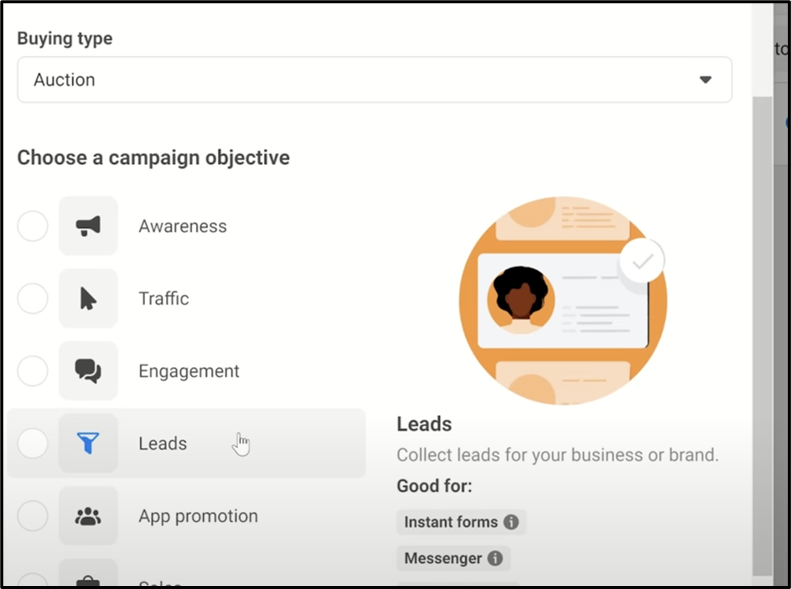
(Image: Meta screenshot)
5. Choose your audience
Audience targeting on Facebook Ads Manager allows you to include (or exclude) people based on their reported interests, age, or location, ensuring that you reach the audience most likely to interact with your business.

(Image: Meta screenshot)
To select your audience:
- Select the location, age range, gender, and language you want to target. You can select (or skip) cities based on size or prioritize people who recently showed interest in your brand.
- As you adjust your settings, look at the custom and lookalike audience size guide on the right. It shows how many people your ad might reach.
- The system will also estimate daily interactions and potential Page likes. If you’ve run ads before, these numbers might be more spot-on because Facebook knows your audience better. But remember, these numbers are just rough guesses, not promises.
6. Set your budget
First, decide if you want a daily budget or a lifetime budget.
The daily budget means your ad runs all day and Facebook ensures you don’t spend more than you set (but you have to spend at least $1 a day).
If you pick a lifetime budget, your ad will run for a certain time, and Facebook will spread out how much you spend over that period.
If you’re not ready to show your ad right away, you can choose when to start and stop your ad and even pick the times it appears.
This way, you can show your ad when your potential customers are usually online to make the most of your money.
7. Create a compelling Facebook ad
First, pick the type of ad you want to run. There are eight Facebook marketing ad formats, ranging from a single image or video to multi-image ads to a full collection or slideshow.
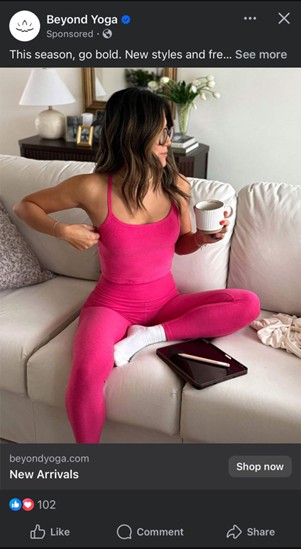
(Image: Single photo ad screenshot)
Consider your ad placement along with the type of ad creative you want to use. While image ads are the most popular choice, video, reels, and carousel ads can enhance your ads, depending on your goals.
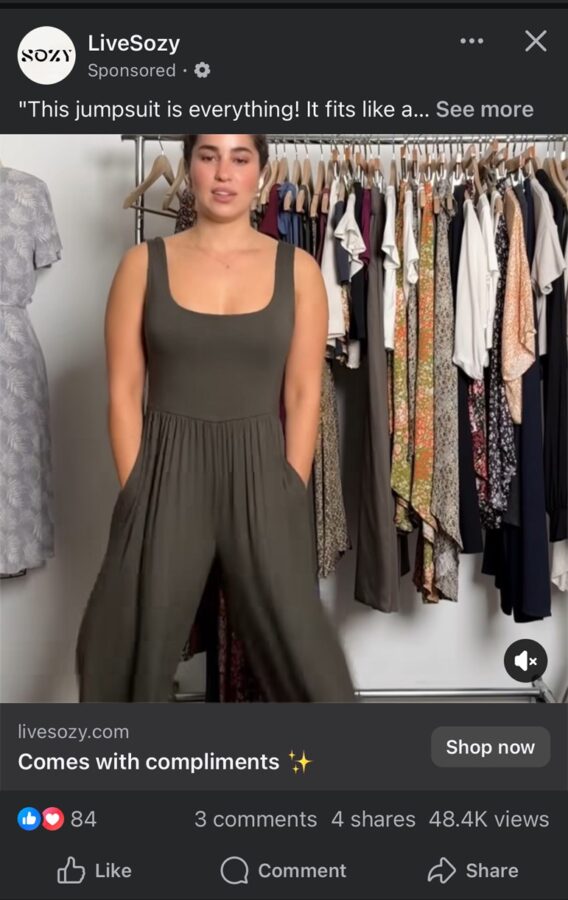
(Image: Video ad screenshot)
Autumn Sullivan from MiQ suggests deconstructing a Facebook ad into its individual parts: text, headline, description, picture, and call-to-action (CTA). You should then clarify the role of each part.
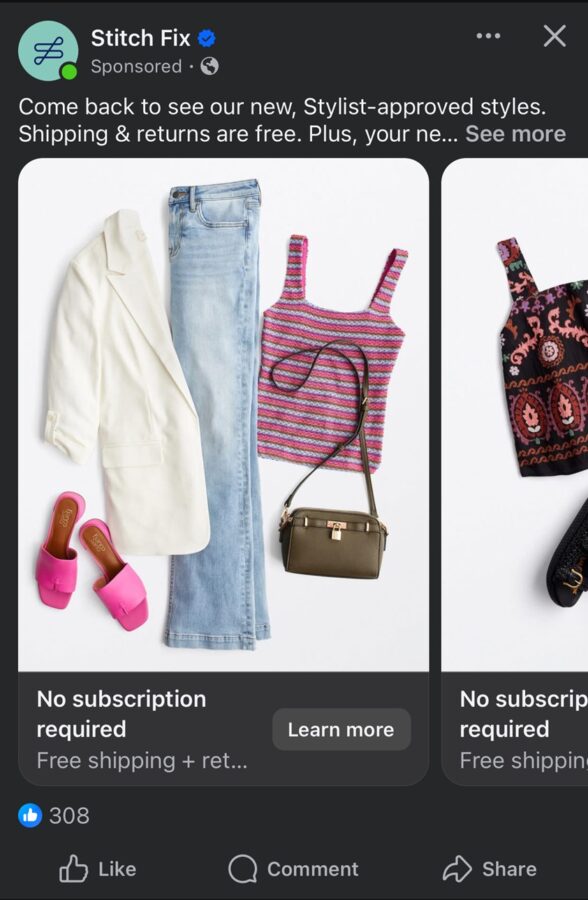
(Image: Carousel ad screenshot)
“The main content should pinpoint what the customers are struggling with and present solutions,” says Sullivan. “Your headline’s job is to capture and retain their interest. The description is there to give more information and foster trust.”
Even though Facebook doesn’t give too many CTA choices, always pick the one that best aligns with the desired action you want the user to take.

(Image: HawkSEM)
Check the preview to see how your ad will appear in different places on Facebook. If everything looks right, hit the “Publish” button to get your new ad live.
8. Track and optimize your results
Once you launch, it’s time to monitor and optimize. You can do this from either Facebook Ads Manager or your ad software.
Facebook provides several important metrics to track, which you can see in Ads Manager:
- Performance Metrics: Captures results, reach, frequency, and impressions
- Engagement Metrics: Revolves around likes, overall page engagement, and interactions with individual posts
- Video Metrics: Shows key indicators like total video views and the average portion of videos watched by viewers
- Website Metrics: Measures actions on your website, such as checkouts, purchases, and items added to the cart
- App Metrics: Includes data like app installs, how people engage with your app, and the cost per engagement
- Event Metrics: Focuses on responses to your events and the associated cost for each response
Click Metrics: Shows total clicks, unique clicks, and the cost for each click - Settings Metrics: Delves into specifics such as start and end dates, the name of the ad set, delivery, and ad objective
Tracking can be challenging, especially when you’re looking for data to increase sales.
When building Facebook Ad campaigns for our clients, we use our proprietary software, ConversionIQ, to identify the search terms high-converting audiences use so we can optimize ads and boost conversion potential.
Our tool measures conversions, such as average order value (AOV) and ROAS, which allows data-driven decision-making for your paid search program.
As a cherry on top, you can get landing page design and conversion optimization to turn those clicks into leads and sales.
9. Build a report to share with the team
Finally, after selecting an objective and running your ad for at least two months, it’s time to build reports to show campaign performance.
Here are the steps to create a report:
- Click on “Analyze and Report” from the main menu
- Go to “Ads Reporting”
- Click on “Create Custom Report”
- Open a saved report
- Choose “Save As” beside the save icon. Name your report and select “Schedule Email”
When running and tracking Facebook ads properly, you can extract info from ad campaigns that you can use to enhance other channels such as paid, SEO, and other social platforms.
Remember, while tracking all these metrics is vital, never lose focus on your main advertising goals. Evaluating Facebook’s clicks and conversions will always remain a top priority.
Expert strategies for ads that convert
Now that you know how to create your Facebook ad campaigns, here are some expert strategies to create compelling ads.
Don’t: Reinvent the wheel
Most ads follow a simple problem-solution style framework — and it works.
“First, you need to have a hook. Find out what the hook is going to be, then present the problem and provide a solution,” says paid social expert Nick Shackleford.
“Next, answer these questions: what are the key features of that product or the solution you’re trying to sell? What are the hurdles that you need to overcome? Lastly, what is your call-to-action (CTA)?”
A mix of these seven variables is an excellent way to create compelling ads.
- Angle/Idea
- Hook
- Problem setup
- Solution
- Benefits (the big promise)
- Response to objections
- CTA
Do: Speak the audience’s language
Rule of thumb for building connections with your audience: “Speak the audience’s language,” says Bryan Clayton, CEO at GreenPal. “It’s not just about what you want to say; it’s about what they want to hear.”
Effective ad copy feels like you’re speaking directly to the consumer. By grasping who the readers are, you can tailor your message, tone, and wording to truly connect with them.
Don’t: Be pushy or aggressive
“When it comes to advertising on Facebook, it’s important to strike the right balance. People don’t appreciate a pushy or aggressive approach,” advises seasoned content strategist Sayem Ibn Kashem.
“It’s crucial to create ads that feel like a friendly conversation rather than a sales pitch. Be authentic, share your story, and showcase how your product or service can genuinely improve people’s lives.”
Kashem also suggests using captivating visuals that tell a story and catch people’s attention.
“Think of it as inviting them to a casual chat over coffee, rather than forcing a sales agenda on them,” notes Kashem.
“By creating ads that connect with and resonate with your audience, you’re not just selling products; you’re building relationships that can do lead generation and create conversions. It’s like finding common interests with a friend at a party – it just feels right.”
Do: Ensure your ad visuals and copy are in sync
Kashem posits visual elements should work in harmony with the copy. “Say I’m advertising a cloud storage service. Instead of using stock photos of clouds, I’d create a visual showing a stressed-out person turning relieved and happy after using our service,” explains Kashem.
“The visual echoes the ad copy, which might say something like “Never Worry About Losing Your Files Again.”
At HawkSEM, we pay attention to the entire user journey, from impression to click to landing page.
“We align copy and ad imagery to the post-click experience,” says lead strategist Nicole Goodnough. “If you click on an ad for motorcycle helmets and land on a page for nursing bras, that’s a bad experience, and conversion rates will suffer.”
Pro tip: Meta Pixel reports track how many people watched your whole video ad and the average time they spent watching. Analyze the watch time, then make new videos the right length to get more results.
Don’t: Set it and forget it
Alexander Zuidam, the head of Sales and Marketing at upMention shared that “a Facebook ad strategy is never a set-it-and-forget-it game plan.”
Facebook’s advertising features and algorithms are constantly evolving. “So it’s vital to adjust your messaging and how you target your audience quarterly,” says Zuidam.
And be sure to experiment with different types of content, ad formats, and ad targeting options.
“We’ll leverage influencer marketing for three months,” explains Zudaim. “Then, for the next three, we’ll prioritize paid ad campaigns. This keeps our social media presence and messaging fresh and relevant for our customers.”
Clayton echoes this sentiment. “You don’t just launch a campaign and walk away, expecting results to roll in. You have to monitor those metrics. Make adjustments based on what the data is telling you.”
Do: Prioritize performance
By focusing on ROI, you can prevent unnecessary ad spend and ensure the budget is spent in the right strategies that bring tangible returns.
“We take an ROI and performance approach when it comes to Facebook ads,” says Yadegar.
“Not only do we identify your target, and demographics, but we also look at important factors such as desired ROAS, cost per acquisition, scalability, and lifetime value of a customer.”
“Further, we track all steps of the customer journey with ConversionIQ to really understand what is working and how to optimize towards results,” adds Yadegar.
Pro tip: A/B test Facebook ads to improve your ad performance. Experiment with different ad formats and styles to help you pinpoint what improves engagement with the target audience.
The takeaway
Facebook ads can be a game-changer for big and small businesses looking to effectively engage their target audience. By following these expert strategies and tips, you can ensure your campaigns are set up for success.
However, while Facebook advertising offers a broad framework, the specifics will depend on your business’s unique requirements and goals.
To truly harness the power of Facebook ads, adopt a mindset of continuous experimentation, testing, and refinement.
Need a hand getting started? Talk to the social media marketing experts at HawkSEM.
This post has been updated and was originally published in December 2023.
